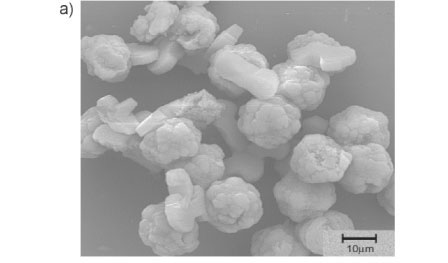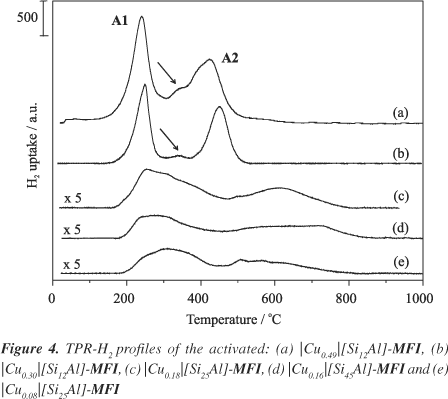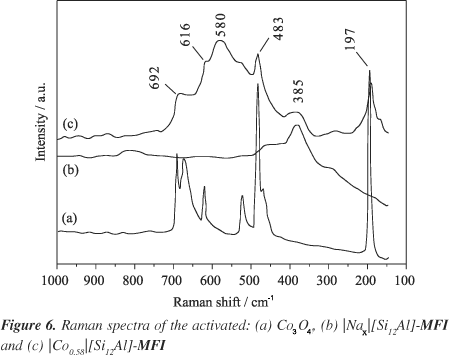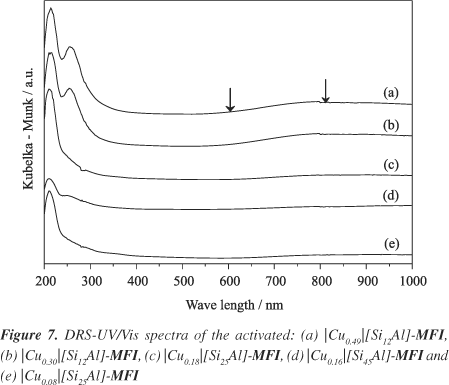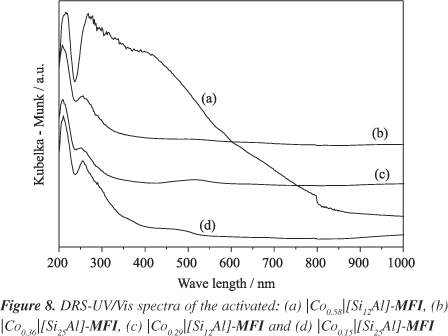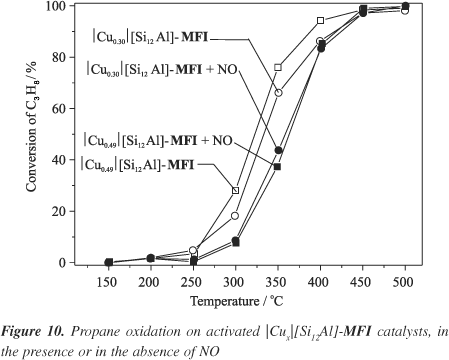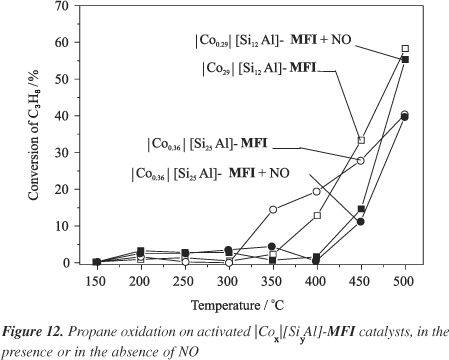Abstract
|Cu x|[Si yAl]-MFI and |Co x|[Si yAl]-MFI catalysts were prepared by ion exchange from |Na|[Si yAl]-MFI zeolites (y = 12, 25 and 45). The activity of the catalysts was evaluated in the reduction of NO to N2 in an oxidative atmosphere using propane or methane as reducing agents. The Cu catalysts were only active with propane and they presented higher activity than the Co-based catalysts, the latter being active with both hydrocarbons. H2-TPR and DRS-UV/Vis data allowed correlation between the activity towards NO reduction and the presence of cationic charge-compensating species in the zeolite. It was also verified that the hydrocarbons are preferentially oxidised by O2, a reaction that occurs simultaneously with their oxidation with NO.
|Cu x|[Si yAl]-MFI; |Co x|[Si yAl]-MFI; NO reduction; propane oxidation
ARTIGO
Cu and Co exchanged ZSM-5 zeolites activity towards no reduction and hydrocarbon oxidation
Leandro Martins; Robson Pablo Sobradiel Peguin; Ernesto Antonio Urquiet-González* * e-mail: urquieta@power.ufscar.br
Departamento de Engenharia Química, Universidade Federal de São Carlos, CP 676, 13560-970 São Carlos SP
ABSTRACT
|Cux|[SiyAl]-MFI and |Cox|[SiyAl]-MFI catalysts were prepared by ion exchange from |Na|[SiyAl]-MFI zeolites (y = 12, 25 and 45). The activity of the catalysts was evaluated in the reduction of NO to N2 in an oxidative atmosphere using propane or methane as reducing agents. The Cu catalysts were only active with propane and they presented higher activity than the Co-based catalysts, the latter being active with both hydrocarbons. H2-TPR and DRS-UV/Vis data allowed correlation between the activity towards NO reduction and the presence of cationic charge-compensating species in the zeolite. It was also verified that the hydrocarbons are preferentially oxidised by O2, a reaction that occurs simultaneously with their oxidation with NO.
Keywords: |Cux|[SiyAl]-MFI, |Cox|[SiyAl]-MFI; NO reduction; propane oxidation.
INTRODUCTION
Environmental laws, which regulate the level of emission of nitrogen oxides (NOx) and other primary pollutants into the atmosphere, are becoming more restrictive. Thus, a large number of studies that aim to improve the catalytic conversion of NOx to N2 by decomposition or reduction are being performed1,2. Special attention has been given to the selective catalytic reduction of NO with hydrocarbons (SCR-HC) under oxidative conditions, which is a potential solution for the treatment of exhaust gases that are generated by diesel engines or other combustion processes3.
In such processes the use of transition metal exchanged zeolites, as selective catalysts, has been proposed. Since the initial study by Iwamoto and Hamada4, which demonstrated that Cu exchanged ZSM-5 (|Cux|[SiyAl]-MFI) are active catalysts for the SCR-HC, several types of this catalyst have been intensively studied. The possible species present in |Cux|[SiyAl]-MFI type catalysts, generally identified by FTIR, H2-TPR, EPR or EXAFS, are copper cations (Cu2+), oxocations (Cu-O-Cu)2+ or copper oxide (CuO)5. The presence of one particular species in the metal-exchanged zeolite depends on the exchanged metal content, on the pH value used during the ion exchange and on the atmosphere used during the subsequent thermal treatment. According to Gómez et al.6, the cationic species Cu2+ and Cu+ in Cu-catalysts have an important role in the catalytic reduction of NOx by hydrocarbons. Although these Cu based zeolitic catalysts show high activity for the SCR-HC from 400 to 800 ºC, they deactivate rapidly in an atmosphere which contains excess of water and/or sulphur oxides7. On the other hand, in contrast to Cu-based catalysts, zeolites containing Co-species have been demonstrated to be more promising due to their better catalytic performance under hydrothermal conditions8.
In addition to the deactivation by water vapour of Cu and Co-exchanged ZSM-5 zeolites during the SCR-HC, it has also been pointed out that preferential direct hydrocarbon oxidation by O2 rather than the desired reaction with NO can occur2, such behaviour limiting their activity towards the SCR-HC and more intensely at temperatures higher than 450 ºC (Table 1, reactions 2 and 4)9. Although some water is formed in these reactions (lower than 0.6%, v/v), the amount present is not plausible to cause appreciable deactivation7.
In the discussed field, the present study aims to verify the activity of |Cux| and |Cox|[SiyAl]-MFI catalysts in the NO reduction, using methane or propane as reducing agents, and for the simultaneous hydrocarbon oxidation with O2. The results obtained will be related to the metallic species formed during the preparation and activation of the catalysts.
EXPERIMENTAL PART
Preparation of the catalysts
The precursor |Na|[SiyAl]-MFI zeolites (where y = 12, 25, and 45 represent the Si/Al ratio in the solid and MFI the ZSM-5 structure)11,12 were synthesised as described elsewhere13. The synthesis was achieved using n-butylamine (C4H9NH2 98%, Riedel-de-Häen) as organic template and sodium trisilicate (Na2Si3O7×H2O 99%, Aldrich) and aluminium sulphate hydrate (Al2SO4×1418H2 O 99%, Reagen) as silica and aluminium sources, respectively. The zeolites were crystallised under autogenous pressure in static conditions at 170 ºC. After the synthesis, the n-butylamine occluded in the microporous of the zeolite was removed by calcination at 520 ºC for 16 h, using a heating rate of 1 ºC min-1 and an air flow of 40 mL min-1 gcatalyst-1. The |Cux| and |Cox|[SiyAl]-MFI catalysts (where x represents the metal/aluminium ratio) were obtained from the precursor |Na|-zeolite by ion exchange in aqueous solutions of 0.015 mol L-1 of copper (II) acetate (Cu(O-CO-CH3)2 99%, Merck) or of cobalt (II) acetate (Co(O-CO-CH3)2 99%, Carlo Erba), respectively. A metal/Al ratio of 1.3 was employed and in order to obtain samples with different Cu and Co contents, the ion exchanges were carried out varying the temperature, the time and the number of exchanges. After each ion exchange, the solids were separated by filtration, washed with deionised water, dried at 110 ºC for 12 h and subsequently activated by heating under air flow at 520 ºC for 1 h, using a heating rate of 10 ºC min-1.
Characterisation
In order to analyse the catalysts with similar chemical characteristics, all samples, prior to be submitted to the different characterisation techniques, they were activated as described above.
The Si/Al ratio of the precursor |Na|[SiyAl]-MFI zeolites was determined using atomic absorption spectroscopy (AAS) and the MFI structure was verified by powder X-ray diffraction (XRD), using a Rigaku Miniflex diffractometer operated with a Cu-Ka radiation and with a goniometer velocity of 2° (2Q)/min. The morphology of the crystals (size and shape) were determined by scanning electron microscopy (SEM) using a Zeiss DSM 960 microscope operated at 30 kV and with a focus distance between 9 and 14 mm.
The 27Al MAS NMR spectra of the precursor |Na|[SiyAl]-MFI zeolites were obtained on a Varian Unity 400 MHz spectrometer, which worked with a frequency of 104.2 MHz. Aiming to excite only the central transition of the 27Al nuclei, p/16 pulses of 0.4 ms and repetition times of 2 s were used.
The temperature programmed reduction by hydrogen (TPR-H2) of Cu- and Co-catalysts was carried out using a Micromeritics 2705 equipment having a thermal conductivity detector. It was used a heating rate of 10 ºC min-1 and a mixture of 5.1% of H2 in N2 (v/v) fed at a flow rate of 30 mL min-1. An amount of 150 mg of sample, previously dried at 110 ºC for 12 h was used in the analysis. To avoid the influence of the physically adsorbed water in the analysis, the samples were previously treated at 200 ºC for 1 h under air flow (30 mL min-1). The water produced during the H2-TPR was removed through a cold trap.
Raman spectra of Co-catalysts were obtained at room temperature using a radiation of 633 nm from a Ne ion laser that was equipped with a CCD detector. The equipment was operated with a spot size of 1 µm in diameter and a potency that was varied from 70 to 175 µW.
The analysis in the UV/VIS region by diffuse reflectance spectroscopy (DRS) was also performed at room temperature with a Varian Cary 5G spectrometer utilising a Teflon sample holder, a quartz window and a Teflon reference standard. The data obtained were processed by applying the Schuster-Kubelka-Munk function F(R).
Catalytic tests
The activity of the |Cux| and |Cox|[SiyAl]-MFI catalysts was evaluated in the reduction of NO to N2, using methane or propane as reducing agents, in an oxidative atmosphere. To avoid the formation of hot spots, the catalytic tests were carried out using 50 mg of the catalyst mixed with 150 mg of quartz. The gas mixture (70 mL min-1) was composed of: 0.3% NO, 1.8% O2, 0.3% C3H8 (or 0.3% CH4) in He (v/v). These operational conditions resulted in a gas hourly space velocity (GHSV) of 42,000 h-1, calculated considering the total gas flow fed to the reactor. The reaction temperature was varied from 150 to 500 ºC.
The products were analysed using a gas chromatograph (Shimadzu-GC-17A) equipped with a flame ionisation detector (FID), a thermal conductivity detector (TCD) and three columns: a capillary (Al2O3/KCl, 30 m ´ 0.32 mm) and two packed columns (Hayesep D (3 m ´ 1/8²) and Chromossorb 102 (5 m ´ 1/8²)).
The carbon balance was monitored during the reaction and the activity of the catalysts for the hydrocarbon oxidation was expressed in terms of the total hydrocarbon conversion. The conversion of NO (XNO) was based on the formation of N2 according to the equation: XNO [%]= 2 [N2] ´ 100/[NO]0, where [N2] = moles of N2 formed and [NO]o = moles of NO fed into the reactor.
RESULTS AND DISCUSSION
Precursor characterisation
The XRD patterns of the synthesised |Na|[SiyAl]-MFI zeolites (Figure 1) reveal the presence of the MFI structure that is typical for ZSM-5 zeolites12. From Figure 1 it can also be observed for sample |Na|[Si45Al]-MFI, the presence of a low intensity peak at 26.64 º(2Q). This peak corresponds to the reflections related to the a-quartz (101) atomic plane12.
The Si/Al ratios used in the synthesis gel and those corresponding to the obtained |Na|[SiyAl]-MFI are shown in Table 2. The crystallinity of the samples (Table 2) was calculated from the XRD data (Equation 1) using the |Na|[Si45Al]-MFI sample as reference (crystallinity = 100%), since it presented the XRD pattern with the highest peak intensity in the range 22° < 2Q < 25º.
Although the crystallinities of the |Na|[Si12Al]-MFI and |Na|[Si25Al]-MFI samples were lower than that of sample |Na|[Si45Al]-MFI, neither the XRD patterns nor the SEM micrographs (Figure 2) indicate the presence of amorphous material or other phases. At this point, the reduced intensity of the X-ray reflections may be attributed to the smaller crystal size of these zeolites (see Figures 2a and 2b).
From data given in Table 2 it can be seen that the Si/Al ratios of the synthesised zeolites were lower than those of the correspondent synthesis gels, indicating that aluminium is preferentially incorporated in the zeolite structure14, and subsequently part of the silica remains as sodium silicate in the liquid phase of the reaction mixture.
Figure 2 shows the SEM micrographs of the |Na|[SiyAl]-MFI zeolites. It can be seen that the aluminium rich zeolite |Na|[Si12Al]-MFI (Figure 2a) crystallises foring agglomerates (ca. 15 µm) of small crystals (ca. 3 µm or lower). With the decrease in aluminium content, isolated or twinned hexagonal prisms are formed with dimensions of approximately 20 and 60 µm, as can be seen in the case of |Na|[Si25Al]-MFI and |Na|[Si45Al]-MFI, respectively (Figures 2b and 2c). As mentioned above, no amorphous material was observed in the SEM micrographs of the |Na|[Si12Al]-MFI and |Na|[Si25Al]-MFI (Figures 2a and 2b). On the other hand, Figure 2c shows for |Na|[Si45Al]-MFI the presence of small particles (< 1 mm), other than the zeolite crystals. These small particles are probably crystals of a-quartz, which was detected by XRD (Figure 1).
27Al MAS NMR spectra of the |Na|[SiyAl]-MFI zeolites (Figure 3) show a resonance peak at around 53 ppm, which is attributed to tetrahedrally co-ordinated Al atoms that are incorporated into the zeolite framework. For the |Na|[Si12Al]-MFI and |Na|[Si25Al]-MFI zeolites an additional signal at 0 ppm is observed, which increases with the increase in aluminium content. This signal is associated to the extra-framework octahedrally co-ordinated aluminium, whose phase was not observed by SEM, indicating that it is well dispersed on the external surface or in the micropores of the ZSM-5 crystals. In addition to the lower |Na|[Si12Al]-MFI and |Na|[Si25Al]-MFI crystal size above commented, the presence of extra-framework aluminium might also explain the lower crystallinity observed by XRD.
Catalyst characterisation
The elemental composition (Table 3) reveals that in the preparation of Cu-catalysts, the copper content in the samples increases when the exchange temperature is increased from 25 to 50 ºC or when the exchange is repeated. As can also be seen from Table 3, the same tendency is observed for Co-catalysts when the temperature was increased from 25 to 80 ºC.
The TPR-H2 data for the Cu- and Co-containing catalysts is presented in Figure 4 and Figure 5, respectively, and the observed reduction temperatures and the ratio of consumed H2 per metal content are showed in Table 4.
As can clearly be observed in Figure 4 and from the data in Table 4 the reduction of |Cux|[SiyAl]-MFI catalysts occurs in two well-defined steps, the two peaks having maximum at temperatures between 240 and 305 ºC and between 420 and 600 ºC, respectively. Torre-Abreu et al.15. attributed the low-temperature peak to the reduction of Cu2+ to Cu+ and the peak at higher temperature to the reduction of Cu+ to Cu0. After the TPR analysis, the presence of elemental copper was confirmed by the reddish colour of the samples. Figure 4 and Table 4 also reveal that irrespective of the Si/Al ratio of the zeolite, the reduction temperatures of Cu2+ and Cu+ increase as the copper content decreases. For samples with similar copper content, the reduction temperatures are higher for that with the highest Si/Al ratio. This behaviour might be explained by the lower electronic density of samples with lower aluminium content, which makes the reduction of the metal difficult. Similar trends were observed by Sullivan and Cunningham16, who attributed such phenomena to an enhanced interaction between the cationic copper species and the zeolite structure. In the TPR-H2 profiles of samples with higher Cu content, |Cu0.49|[Si12Al]-MFI and |Cu0.30|[Si12Al]-MFI, can be observed a small shoulder at around 350 ºC (indicated in Figure 4 with an arrow), which might be attributed to the reduction of finely dispersed CuO particles to elemental Cu0 17,18. As can be seen from Table 4, the sum of H2/Me ratio corresponding to peak 1 (A1) with the H2/Me ratio corresponding to peak 2 (A2) does not correspond to the total hydrogen consumption (H2/Me total). This difference in the H2 consumption might be attributed to the presence of CuO, whose content in each catalyst (show in Table 5) was estimated considering the stoichiometry of the CuO reduction: CuO + H2® Cu0 + H2O; resulting in 0.4 and 0.17% w/w for the |Cu0.49| and |Cu0.30|[Si12Al]-MFI, respectively.
CuO can be formed during calcination from hydroxylated species generated during the ion exchange19, such as Cun+(OH)n, Cu(n+m)+(OH)m(O-CO-CH3 )n or Cun+(OH)m(n-m)+, resulting in a pH decrease from 5.5 to 4.9.
As can be seen from the TPR-H2 profiles of Figure 5, all the |Cox|[SiyAl]-MFI catalysts show an intense reduction peak with maximum at temperatures between 660 and 720 ºC (Table 4). Wang et al.20. and Cruz et al.21. attributed this peak to the reduction of Co2+ to Coº in charge- compensating sites of the zeolite structure. For the |Co0.58|[Si12Al]-MFI catalyst, which has the highest cobalt content, the low intensity reduction peak at around 320 ºC, might be attributed to the reduction of cobalt oxide species. As in the case of CuO, the Co3O4 content in the Co-catalysts (Table 5) was estimated from the stoichiometry of its reduction, using the consumed H2 (peak at 320 ºC), resulting for the |Co0.58|[Si12Al]-MFI in 0.7% w/w. In the other samples this peak was not observed, probably due to their lower cobalt content. As in the case of Cu-catalysts, the formation of cobalt oxides is also related to the formation of cobalt hydroxide species during ion exchange, where a pH decrease from 6.0 to 4.9 was observed.
As mentioned, Table 4 also presents the ratio of total consumed H2 per metal content for Cu and Co-catalysts. Theoretically, for each divalent metal cation (Me2+) reduced to Me0 the H2/Me ratio should be equal to 1. H2/Me values below 1 could indicate incomplete reduction of the metal, while values higher than 1 could be related to the simultaneous reduction of species other than the Me2+ cations. For Cu-catalysts no significant deviation from 1 is observed, indicating complete reduction of copper species. For the sample |Co0.58|[Si12Al]-MFI a value of H2/Me equal to 1.32 was obtained, which can be explained by considering the simultaneous reduction of Co2+ and trivalent Co3+. The trivalent species are present due to the partial oxidation of Co2+ (present in CoO) to give Co3+ and generating Co3O4. Similar observations were made by Wang et al.20 for cobalt-containing ZSM-5 zeolite.
In order to obtain further information about the Co-oxide species present in the Co-catalysts, Raman measurements were performed. Figure 6 shows the spectra obtained from the |Co0.58|[Si12Al]-MFI catalyst, Co3O4 (reference sample) and the zeolite used as precursor. As can be seen, the bands at 303 and 385 cm-1 in the spectrum of |Co0.58|[Si12Al]-MFI correspond to the zeolite framework and they are not related to the Co-species22. In addition, bands at 197, 483, 529, 616 and 692 cm-1 can be observed in the spectra. These bands are attributed to Co3O4 agglomerates, which must be smaller than 3 nm, as they were not detected by XRD. In the same spectrum, a band at around 580 cm-1 is also observed. As this band can not be attributed to the zeolite framework nor to Co3O4, it is suggested that it corresponds to a loaded cobalt species other than Co3O4 (e. g. CoO(OH))22.
Figure 7 shows the DRS-UV/VIS spectra of the |Cux|[SiyAl]-MFI catalysts. The presence of bands at around 212, 256 and a broad, but weak band between 600 and 850 nm can be observed. Itho et al.23 reported that the band at 212 nm, which appears in the spectra of all samples, is related to the zeolitic support and therefore not related to the Cu-species. The band at 256 nm is attributed to Cu2+ interacting with oxygen atoms in the zeolite structure and the band between 600 and 850 nm to Cu2+ cations in hexagonal coordination (this band is indicated in Figure 7 between arrows)23,24. Although the above discussed TPR-H2 results suggest the presence of small amounts of CuO in the |Cux|[SiyAl]-MFI catalysts, in their DRS-UV/VIS spectra there is no band at around 890 nm, which could indicate the presence of this species25. This fact could be a consequence of the low concentration of CuO in the samples.
In the DRS-UV/VIS spectra of |Cox|[SiyAl]-MFI catalysts bands at 210, 255 and between 415 600 nm can be observed (Figure 8). The latter, which is present only in samples with a high metal content, is attributed to Co3O4 oxide26. The bands at 210 and 255 nm are associated to the electronic transitions of the zeolite structure and to Co2+ species compensating the negative charge of the zeolite, respectively.
In the activated |Co0.58|[Si12Al]-MFI sample, these bands are broader and more intense, particularly the band at 415 600 nm. Therefore, in this catalyst, Co3+ species are probably present in a higher proportion, thus explaining its higher H2/Co ratio obtained in the TPR (see Table 4) and the Co3O4 bands detected by Raman spectroscopy.
Catalytic evaluation
In the following discussion about the activity of the Cu- and Co-catalysts, it was not considered the effect of water generated in the hydrocarbon oxidation. As mentioned, the amount of water formed (lower than 0.6% v/v) is not plausible to cause appreciable deactivation7.
Figure 9a shows the conversion of NO to N2 on |Cux|[SiyAl]-MFI as a function of the reaction temperature, using propane or methane as reducing agent. It can be observed that the conversion of NO depends on the temperature, the type of hydrocarbon and the copper content.
The |Cux|[Si12Al]-MFI catalysts, in comparison with the precursor |Na|[Si12Al]-MFI zeolite (Figure 9), are active catalysts for the conversion of NO to N2 in the presence of propane and their activity increases as the copper content increases. For propane oxidation, the activity of the studied |Cux|[SiyAl]-MFI catalysts was not influenced by the metal content and it was only slightly modified in the presence or in the absence of NO (Figure 10). When NO was fed to the reactor, the propane conversion decreased due to the competition between propane and NO for the active sites of the catalyst (Table 1, reactions 1 and 2). On the other hand, Figure 9 reveals that |Cux|[SiyAl]-MFI catalysts are not active in the reduction of NO in the presence of methane and also show low activity in the oxidation of this hydrocarbon. This behaviour was also observed by Li and Armor27 and it is probably related to the high energy necessary for the C-H dissociation in methane, which is following Adelman et al.28, the limiting step in the reduction of NO by alkanes over copper-containing ZSM-5 zeolites. For the |Cux|[SiyAl]-MFI catalysts in the tests using propane, it can be seen that the conversion of NO increases more slightly at temperatures higher than 400 ºC. This behaviour is attributed to an increase in the desorption rate of NO at higher temperatures and to a decrease in the propane concentration, which is associated with the increase of its direct oxidation by O2 at those temperatures (Table 1, reaction 2).
Figure 11 shows that |Cox|[SiyAl]-MFI catalysts have low activity for the reduction of NO to N2 in the presence of propane. On the other hand, in the presence of methane, which is also partially converted, |Cox|[SiyAl]-MFI catalysts reduce in more extension NO to N2 (Table 1, reaction 3), with the conversion increasing with the increase in the cobalt content in the catalyst. This behaviour, which differs from that obtained on |Cux|[SiyAl]-MFI catalysts using the same hydrocarbon, might be explained by the different intermediate nitrogen species formed on each catalyst. Adelman et al.28 found that in the presence of NO and O2, nitro and/or nitrate complexes ([Cu(NO2)y]2+ or Cu[(NO3)y](2-y)+) are predominantly formed on |Cux|[SiyAl]-MFI, while nitrite complexes ([Co(ONO)y]2+) are predominant on |Cox|[SiyAl]-MFI catalysts. The latter are reduced upon exposure to CH4 leading to the formation of N2 and different methane oxidation products, while the nitro and/or nitrate complexes are chemically reduced to N2 upon exposure to C3H8 and remain inert in the presence of CH4.
Figure 12 shows the conversion of propane on |Cox|[SiyAl]-MFI catalysts with different cobalt contents. As can be observed, these catalysts show similar behaviour that was observed for the copper-containing catalysts, in which the conversion of propane was decreased due to the competition between NO and propane for the active sites.
The analysis of the reaction products by gas chromatography demonstrated that the oxidation of propane on copper-catalysts was more selective towards the formation of CO2. For propane and methane oxidation on cobalt-catalysts, in addition to CO2, partially oxidised hydrocarbons, such as aldehydes and ketones, were also observed.
Considering the total metal content in the studied catalysts (Table 3), Table 5 shows the observed specific activity during the reduction of NO to N2 on |Cux| and |Cox|[SiyAl]-MFI. As can be seen, the higher the Cu loading in the in the former catalysts the lower their specific activity. This behaviour might be attributed to the different metal content in the catalytic bed and to the different nature of the Cu2+ cations as was commented during the discussion of the TPR-H2 analyses. On the other hand, for a higher metal content in the Co-catalysts a slightly higher specific activity is observed. As can also be seen in Table 5, the amount of metallic oxide present in the samples increases with the metal content. The specific activity and TPR-H2 data of Cu-catalysts can indicate that CuO species are practically not active, however Co3O4 species seem to favour the activity of Co-catalysts.
CONCLUSIONS
The synthesised |Na|-zeolites presented MFI structure and it was observed that with the decrease in aluminium content their morphology changed from aggregates of small crystals to isolated or twinned hexagonal prisms. The species present in |Cux| and |Cox|[SiyAl]-MFI catalysts were mostly Cu2+ and Co2+ cations, which are compensating the negative charge of the zeolite structure. In the catalysts with higher metal content it was also evidenced the presence of metal oxides, generated during the calcination of Me(OH)2, Me2+(OH)- or Me(O-CO-CH3)2 species, which are formed during ion exchange.
In the reduction of NO the activity of the catalysts increased as the content of the charge-compensating Cu2+ and Co2+ species increased. |Cux|[SiyAl]-MFI catalysts were only active in the presence of propane and they showed higher activity at lower temperatures than the |Cox|[SiyAl]-MFI catalysts, the latter being more active with methane.
It the oxidation of hydrocarbons the Co-based catalysts were less selective for the formation of CO2. For both type of studied catalysts it was verified that in detriment to the desired oxidation with NO, occurs preferentially their oxidation with O2.
Recebido em 4/1/05; aceito em 29/6/05; publicado na web em 20/1/06
- 1. Pârvulesku, v. i.; Grange, P.; Delmon, B.; Catal. Today 1998, 46, 233.
- 2. Rangel, M. C.; Carvalho, M. F. A.; Quim. Nova 2003, 26, 265.
- 3. Amiridis, M. D.; Zhang, T.; Farrauto, R. J.; Appl. Catal., B 1996, 10, 203.
- 4. Iwamoto, M.; Hamada, H.; Catal. Today 1991, 10, 57.
- 5. Beutel, T.; Sarkany, J.; Lei, G. D.; Yan, J. Y.; Sachtler, W. M. H.; J. Phys. Chem. 1996, 100, 845.
- 6. Gómez, S. A.; Campero, A.; Marínez-Hermández, A.; Fuentes, G. A.; Appl. Catal., A 2000, 197, 157.
- 7. Tabata, T.; Kokitsu, M.; Okada, H.; Sabatino, L. M. F.; Catal. Today 1996, 27, 91.
- 8. Li, Y; Battavio, P. J.; Armor, J. N.; J. Catal. 1993, 142, 561.
- 9. Batista, M. S.; Ph. D. Thesis, Universidade Federal de São Carlos, Brasil, 2002.
- 10. Atkins, P.; Jones, L.; Chemical Principles, 2nd ed., W. H. Freeman and Company: New York, 2001.
- 11. McCusker, L. B.; Liebau, F.; Engelhardt, G.; Pure Appl. Chem. 2001, 73, 381.
- 12. Treacy, M. M. J.; Higgins, J. B.; von Ballmoos, R.; Zeolites 1996, 16, 327.
- 13. Batista, M. S.; Master Thesis, Universidade Federal de São Carlos, Brasil, 1997.
- 14. Jahn, S. L.; Ph. D. Thesis, Universidade Federal de São Carlos, Brasil, 1987.
- 15. Torre-Abreu, T. C.; Henriques, C.; Ribeiro, F. R.; Delahay, G.; Ribeiro, M. F.; Catal. Today 1999, 54, 407.
- 16. Sullivan, J. A.; Cunningham, J.; Appl. Catal., B 1998, 15, 275.
- 17. Carniti, P.; Gervasini, A.; Modica, V. H.; Ravasio, N.; Appl. Catal., B 2000, 28, 175.
- 18. Minchev, C.; Köhn, R.; Tsonsheva, T.; Dimitrov, M.; Fröba, M.; Stud. Surf. Sci. Catal. 2001, 135, 253.
- 19. Martins, L.; Peguin, R. P. S.; Wallau, M.; Urquieta-González, E. A.; J. Braz. Chem. Soc. 2005, 16, 589.
- 20. Wang, X.; Chen, H. Y.; Sachtler, W. M. H.; Appl. Catal., B 2000, 26, L227.
- 21. Cruz, R. S. da; Mascarenhas, A J. S.; Andrade, H. M. C.; Appl. Catal., B 1998, 18, 223.
- 22. Ohtsuka, H.; Tabata, T.; Okada, O.; Sabatino, L. M. F.; Belusi, G.; Catal. Today 1998, 42, 45.
- 23. Itho, Y.; Nishiyama, S.; Tsuruya, S.; Masai, M.; J. Phys. Chem. 1994, 98, 960.
- 24. Moretti, G.; Dossi, C.; Fusi, A.; Recchia, S.; Psaro, R.; Appl. Catal., B 1999, 20, 67.
- 25. Dossi, C.; Fusi, A.; Recchia, S.; Psaro, R.; Moretti, G.; Microporous Mesoporous Mater. 1999, 30, 165.
- 26. Fierro, g.; Eberhardt, M. a.; Houalla, M.; Hercules, D. M.; Hall, W. K.; J. Phys. Chem. 1996, 100, 8468.
- 27. Li, Y.; Amor, J. N.; Appl. Catal., B 1993, 2, 239.
- 28. Adelman, B. J.; Beutel, T.; Lei, G. D.; Sachtler, W. M. H.; J. Catal. 1996, 158, 327.
Publication Dates
-
Publication in this collection
03 Apr 2006 -
Date of issue
Apr 2006
History
-
Accepted
29 June 2005 -
Received
04 Jan 2005


